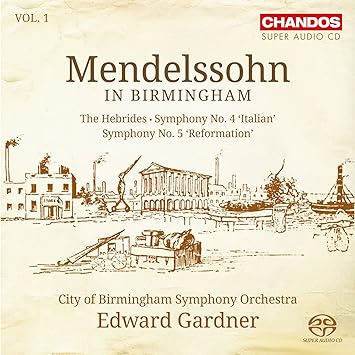The Reformation Symphony is just part of this collection, but allow me to focus on it with Reformation Day just around the corner This is one of my favorite symphonies.
"Mendelssohn in Birmingham" is a 5 part series. It focuses on the German composer's visits to England, and the art work is a drawing by Mendelssohn of his performance in Birmingham. This first release features the overture "The Hebrides," and symphonies #5 (Reformation) and #4 (Italian).
You can divide Mendelssohn's symphonies into three groups: The first, the two he composed but went unpublished until decades after his death, and the final two he composed but were the second and third published. While most composer's works are numbered in order of composition, Mendelssohn's are enumerated by publishing. I read that he did edit the Reformation and Italian symphonies but still didn't publish them; the commentator said the symphonies were better as originally written.
Let me move to the Overture "The Hebrides." It is a concert overture, that is, a stand alone composition. It was inspired when Mendelssohn visited Scotland, and was moved by the basalt sea cave on island of Staffa known as "Fingal's Cave." This composition combines the mysterious with the triumphant.
Mendelssohn started the Reformation Symphony with the goal of it being used to celebrate the 300th anniversary of the Augsburg Confession, written by my favorite Reformer, Philip Melanchthon. Unfortunately, health problems kept it from being performed at the celebration, leading to it not being published until 21 years after the composer's death.
Normally, the symphony's first movement is named after the key it starts in. Beethoven's first symphony was irregular because it started off meandering between the keys of C and F before settling into the former. This symphony was said to be in D major, but after a brief introduction in the stated key, Mendelssohn moved to the main theme in D minor, so this symphony is called in D major/D minor.
In contrast to the opening movement, the second is a joyful minuet in C major, a composition that always puts me in a good mood. One commentator said it didn't fit the theme. I disagree. To me, it captures the joy and freedom we have in Christ, exemplified by the five solas of the Reformation and the recognition of the Priesthood of the believer.
The third movement is slow and short, and without a real break transitions to a flute opening the final movement with the tune of "A Mighty Fortress Is Our God." The meditative beginning transitions to a more upbeat segment.
There are some compositions that, when I hear it, I think I've heard it before but can't name it. This is true of the opening movement of the Italian Symphony. The first movement is lively, followed by a mournful second movement and a cheerful though mostly slow third movement (though it has a couple of rousing fanfares. The finale is one of the most lively conclusions.
One tradition I do for Reformation Day is put on this collection as I'm getting ready to call it a night.

No comments:
Post a Comment